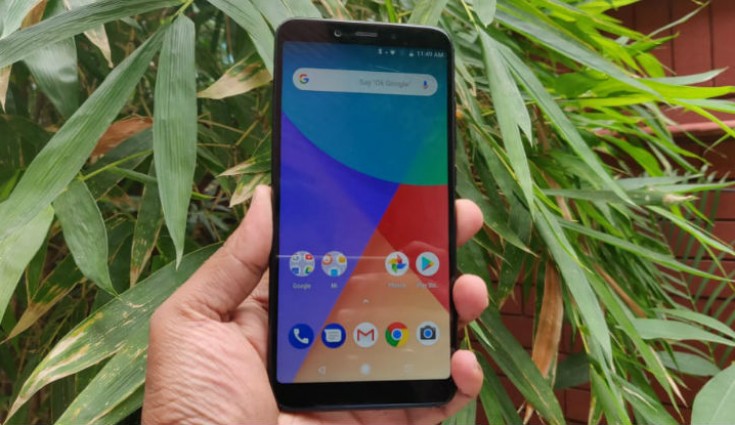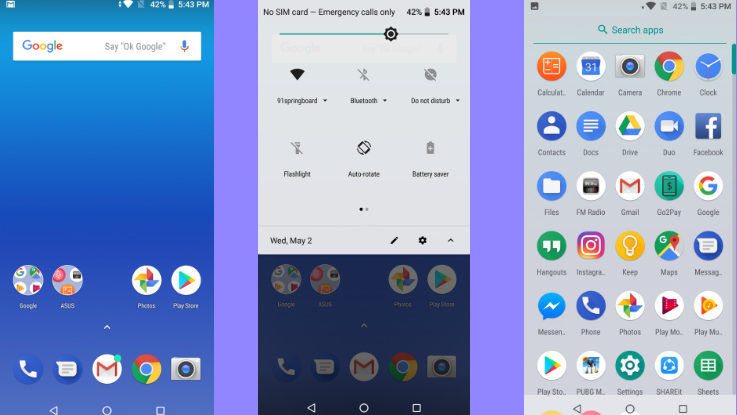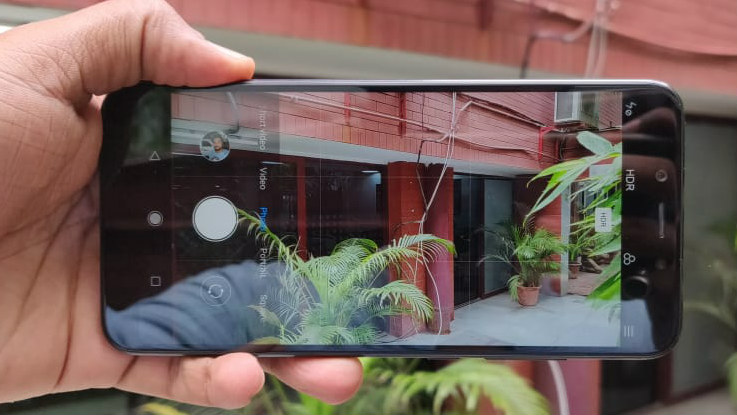Xiaomi has launched its second Android One device – Xiaomi Mi A2, today in India which will be sold as an Amazon exclusive in the country for a starting price of Rs 16,999. The successor to the MI A1 will pack in a handful of mid-range specs with dual camera setup at the back and support for quick charging. The device revolves around Google’s Android One initiative and will thus come with a clean stock version of Android 8.1 Oreo with no major bloatware on top.
For the price that it’s sold for, the Mi A2 will give head-on competition to Asus Zenfone Max Pro M1 and the recently launched Honor Play, both of which retail in India for around the same price and pack an alternate set of features onboard. Let’s find out how the latest Xioami phone lines up to its mid-range alternatives.
Build & Design:
The Mi A2 from Xiaomi takes inspiration from the Redmi Note 5 Pro and thus comes with a familiar metallic panel at the back that extends to the edges to give the phone a grippy finish. As always, Xiaomi has gone for a traditional metallic back instead of the now-trendy glass finish and that indicates that Xiaomi plans to keep its budget phones more durable for day-to-day usage.
.jpeg)
The Honor Play gets the benefit of a metallic body, versus the trending glass design and rightly so, as it’s a device made to withstand the daily roughness of mobile gamers and their frustration. With metal at the back and glass on the front, you’re getting a better grip but also compromising on the elegant looks of a glass device. However, the build is robust and with rounded corners, the device will be preferable for long hours of gaming than the rest of its siblings.
.jpeg)
Th Zenfone Max Pro M1 though designed like any other mid-range smartphone, features a metal unibody with 2.5D curved on the front. Looking at the phone from the back, we can easily distinguish the Asus phone from other metallic framed smartphone since the camera module is aligned vertically and sits flushed with no bump whatsoever. Though a little slippery, the smoother premium finish at the back more than makes up for it.
Winner: Xiaomi Mi A2
Display:
The Zenfone Max Pro M1 packs in an elongated 5.99-inch FHD+ display with a resolution of 2160 x 1080 pixels. The display is well lit with a brightness of 450 nits and a contrast ratio of 1500:1, scoring 85 percent on the NTSC colour gamut. With a thinner lip at the bottom and only some space left at the top for the camera and the earpiece, thus managing to output 76.2 percent screen-to-body ratio with a Pixel density of 402 ppi.

The display on the MI A2 is a 5.99-inch IPS LCD panel in as 18:9 aspect ratio with 2160 x 1080 pixels resolution that outputs a Pixel density of 403ppi. The display looks a lot like Motorola’s G6 with the same thick bezels on both the top and bottom, though the chin is visibly useless. Though there are noticeable bezels on the device, the A2 still manages to trim the screen-to-body ratio by 10 percent when compared to the Mi A1 and this packs in a screen space of 76.2 percent.
.jpeg)
The Honor Play features a much larger 6.3-inch Full HD+ IPS LCD display with a screen resolution of 2340 x 1080 pixels, thus featuring a pixel density of 409 ppi. There are lesser bezels here when compared to the ones on the Zenfone and Xiaomi device and thus the screen-to-body ratio on the phone is 83.0 percent. This is possible due to the notch on top which significantly adds some more screen space to the Play.
Winner: Honor Play
Hardware:
The Honor Play, being gaming-centric smartphone comes with Huawei’s flagship Hisilicon Kirin 970 Chipset which is also seen on many of the high-end phones from Huawei. This coupled with 4GB of RAM and 64GB of internal storage should comfortably keep you on top of your daily tasks. The Honor Play is also the first device to be seamlessly enhanced with GPU Turbo and in our reviewwe found a significant difference playing games on this phone as compared to other Kirin 970-powered smartphones, thus making the Play, one of the powerful devices to bless the smartphone world.
Asus’ Zenfone M1 is powered by the Snapdragon 636 chipset which also powered the popular Redmi Note 5 Pro. The variant in question comes with 6GB of RAM and 64GB of internal storage and as tested in our in-depth review, the Max Pro works like a charm. Day-to-day functions are managed smoothly and the device also does an immersive job in the gaming department and consumes less power as well.
The Mi A2 gets a performance update through the upgraded Snapdragon 660 chipset which replaces the Snapdragon 625 that was present in the Mi A1. This coupled with 4GB of RAM and 64GB of internal storage ensures a smooth performance throughout the day and can handle casual games effectively. However, playing extreme graphics intensive games like PUBG made us witness a significant stuttering and overheating. The device thus gets a beating from the Honor Play which comes with a better specification.
Winner: Honor Play
Software:

The latest ZenUI on the Zenfone Max Pro M1 offers a near-to-stock Android experience on the Android 8.1 Oreo-based interface. The interface is clean with no heavy skins or bloatware and the snappy Snapdragon 636 provides a smoother user interface which is easy to navigate with no lag whatsoever.
The Honor Play from Huawei runs on the new Android 8.1 Oreo with EMUI 8.2 on top. Once you start using it, the interface will look and feel the same as you’ll be greeted with an iOS-like home screen style by default. Although the custom skin provides a ton of personalisation tools, it’s also the reason behind the slowing down of the system which is bound to happen in the long run. There’s a learning curve to keep in mind when buying any of these smartphones but it’s the Honor Play which flaunts the software-optimised GPU Turbo mode for enhanced gaming.
The Mi A2 comes with Google’s Android One branding, meaning the device will give you a pure Android experience with timely updates straight from Google. There’s a handful of Google apps along with some basic Xiaomi applications other than which the interface is virtually bloatfree, unlike Xiaomi’s MIUI firmware. The Mi A2 brings in all the features found on Stock Android Oreo and takes up much lesser memory resulting in a smoother performance.
Winner: Xiaomi Mi A2
Camera:
As good as the Honor Play is in the performance department, the device takes a step back in terms of imaging. The Play sports a trimmed dual-camera setup that comes with a combination of 16-megapixel primary and a mere 2-megapixel secondary sensor. If it hadn’t been for its AI functions like scene and object detection, the Play wouldn’t pass for a camera smartphone one bit. While daylight shots are decent at max, the device doesn’t quite produce as much sharpness and colours in low light conditions. Macro shots are okay-ish while the 16MP front-facing sensor clicks decent selfies.

Xiaomi has upgraded the camera unit on the Mi A2 with a dual 12MP (f/1.8, 1/2.9″, 1.25µm) + 20MP (f/1.8, 1/2.8″, 1.0µm, PDAF) rear camera that clicks pictures with a decent amount of details and close to natural colours, though sharpness is enhanced once HDR kicks in. The 20MP (f/2.2, 1/2.8″, 1.0µm) front-facing camera does a decent job as well and there is a flash in case you want to click selfies in the dark. The colour rendition is good in either set of cameras and so is the Portrait mode which tends to kick in even with subjects other than humans.
Asus’ formula for the camera modules on the Zenfone M1 is a combination of dual 13 MP (f/2.2, 1.12µm) + 5 MP (f/2.4, 1.12µm) lenses which offers phase detection autofocus, a 5 element lens, and a Wide-Angle 80-degree lens. The pictures captured on the device came out with definitive natural colours and details in good lighting. The bokeh effect works on most days but you can expect a drop in quality once a while or under low light conditions. There’s also an 85.5-degree wide angle 8-megapixel front snapper with an Aperture of /2.2 aperture.
Winner: Xiaomi Mi A2
Battery:
For all its goodness, the Mi A2 comes last in the battery department, packing a 3000mAh battery which is the smallest of the three. Thankfully, the company has added Quick Charge 4.0 fast charging, which will top up the power unit under 2 hours.
The Honor Play just about outdoes the Mi A2 with a 3750mAh power unit that will last long, also due to the power efficient Kirin 970 chip. The Play can also be efficiently charged with an 18-watt fast charger which comes bundled with the phone.
The battery is where the Zenfone Max Pro M1 leaves the other two to bite the dust as it equips a massive 5,000mAh battery that will last you to up to two days of moderate use on a single charge. For that large a battery, the bundled 5V/2A 10-watt charger charges up the Asus device to full in about two hours, which is impressive on many levels.
Winner: Asus Zenfone Max Pro M1
Verdict:
The Mi A2 from Xiaomi is certainly a step up from its predecessor as it packs improved an improved sheet of configuration, new design elements, an elongated display, a new camera unit which is been refined severalfold and even packs in Qualcomm’s Quick Charge 4.0-based charging. Not to forget is the stock version of Android Oreo which will get timely updates from Google itself. For a price of Rs 16,999, the Mi A2 does justice by being an all-around device which is also affordable mid-level phone at the same time.
| Xiaomi Mi A2 | Huawei Honor Play | Asus Zenfone Max Pro M1 | |
| Processor | Snapdragon 660 | Hisilicon Kirin 970 | Snapdragon 636 |
| Display | 5.99-inch Full HD+, 1080 x 2160 pixels, | 6.3-inch Full HD+, 2340 x 1080 pixels | 5.99-inch Full HD+, 1080 x 2160 pixels |
| Memory | 4/6GB RAM + 64/128GB storage | 4GB, 64GB storage | 6GB, 64GB storage |
| Camera | Dual: 12MP (1.25µm, f/1.75 aperture) + 20MP ( 1.0µm pixel size, f/1.75 aperture), 20MP front (20MP, 1.0µm pixel size, f/2.2 aperture), 2160p@30fps, 1080p@30fps (gyro-EIS), 720p@120fps, HDR | 16MP (f/2.2, PDAF) + 2MP (f/2.4, depth sensor), 2160p@30fps, 1080p@30fps, 16MP front (f/2.0, 2.0µm) | 16 MP (f/2.0, PDAF) + 5 MP (f/2.4, 1.12µm, depth sensor), 16 MP front, 2160p@30fps, 1080p@30/60fps, HDR, panorama |
| Battery | 3000 mAh | 3750 mAh | 5000 mAh |
| OS | Android 8.1 (Oreo) | Android 8.1 (Oreo); Android One | Android 8.1 (Oreo) |
| Price | Rs 16,999 | Rs 19,999 | Rs 14,999 |
For users who need more performance from a smartphone, especially gamers, the Honor Play checks all the right boxes with a top-of-the-line Kirin 970 chip, a rigid metallic stricture and a decently sized battery that supports fast charging. The Play also packs in the largest display of the three with the most screen-space giving its users an immersive multimedia experience on the go.
While the Mi A2 and Honor Play fight at around the Rs 20,000 mark, it’s the Zenfone Max Pro M1 from Asus that offers a balance of performance and design at a lower price of Rs 14,999, which could possibly be its biggest selling point. However, the Snapdragon 636 Processor comes last among the three and so is the camera which offers no competition to its alternatives.

